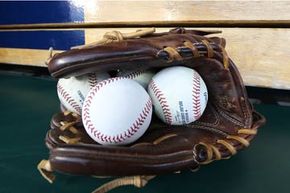In 2007, Rawlings introduced one of the most expensive off-the-shelf baseball gloves ever made [source: Boyle]. Running up to $400, you'd think the Italian-leather, double-layer, wool-lined, hand-sewn Primo would come at least partially broken in.
But no. The owner of a Primo (assuming it's not behind glass) has to soften and shape the glove just like a player with a $30 model.
Advertisement
Why's that? Most gloves are made of thick, heavy leather, usually from cows, and come off the assembly line with very little give. Since it's harder to catch a baseball in a stiff, ill-fitting glove than in a supple one conformed perfectly to your hand, breaking in a glove is standard procedure.
That wasn't always the case. Gloves came to baseball in the 1870s for protection, not performance. They were initially frowned upon by purists as an unmanly attempt to escape the hand injuries that simply came with the sport. But gloves caught on as pitchers found them useful for lessening the bruises they developed from repeatedly catching balls coming from all directions [source: Eye Witness to History].
Now, 150 years later, the glove means almost as much to baseball as the bat. And breaking in a glove might be as significant as catching a ball with it. The ritual applies to 10-year-olds in T-ball and men earning millions in the majors, though their methods may (and often should) differ. Some of the approaches used by Major League Baseball (MLB) players can shorten the life of a glove, but who cares when you've got brand-new, high-quality, free gloves practically thrown at you every year by manufacturers looking for publicity [source: Hise]?
For the rest of us, it's probably best to break in a glove without damaging it.
There are a million opinions on the best way to make a new glove feel like an old friend, but all of them share two goals: softening the leather and forming a pocket for the ball. Softening comes first, and it can damage the glove if you take some of the approaches used by some of the pros.
Advertisement


